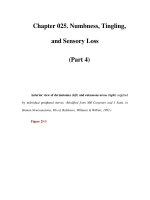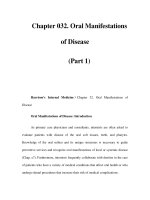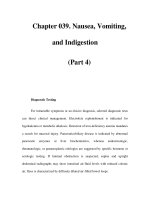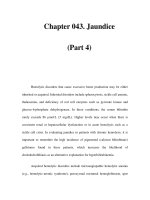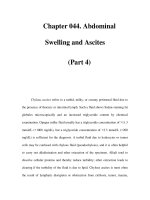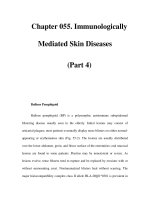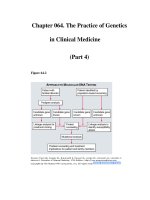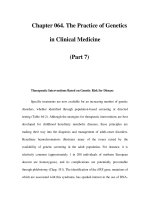Chapter 123. Clostridium difficile–Associated Disease, Including Pseudomembranous Colitis (Part 4) pdf
Bạn đang xem bản rút gọn của tài liệu. Xem và tải ngay bản đầy đủ của tài liệu tại đây (43.37 KB, 5 trang )
Chapter 123. Clostridium difficile–Associated Disease,
Including Pseudomembranous Colitis
(Part 4)
Although limited prospective randomized clinical trials showed no
statistical differences among treatment agents for cessation of diarrhea (the
primary outcome endpoint; Table 123-2), later observational studies suggest that
response rates to metronidazole may have decreased. The clinical response rate for
bacitracin is 10–20% lower than that for vancomycin; therefore, bacitracin use for
first-line therapy is discouraged. All drugs, particularly vancomycin, should be
given orally if possible. When IV metronidazole is administered, fecal bactericidal
drug concentrations are achieved during acute diarrhea, and CDAD treatment has
been successful; however, in the presence of adynamic ileus, IV metronidazole
treatment of PMC has failed. In previous randomized trials, diarrhea response
rates to oral therapy with vancomycin or metronidazole were ≥94%, but two
recent observational studies found that metronidazole response rates had declined
to 74% and 78%. Although the mean time to resolution of diarrhea is 2–4 days, the
response to metronidazole may be much slower. Treatment should not be deemed
a failure until a drug has been given for at least 6 days. On the basis of data for
shorter courses of vancomycin (Table 123-2), it is recommended that
metronidazole and vancomycin be given for at least 10 days, although no
controlled comparisons are available. Although metronidazole is not approved for
this indication by the U.S. Food and Drug Administration (FDA), most patients
with mild to moderate illness respond to 500 mg given by mouth three times a day
for 10 days; extension of the treatment period may be needed for slow responders.
Because of the recent increase in metronidazole failures, patients treated with this
drug should be monitored carefully for progressive defervescence (if fever is
present), alleviation of abdominal pain and tenderness, decreases in the number of
daily bowel movements, and decreases in the white blood cell (WBC) count.
Clinical deterioration, with worsening signs and symptoms, or an unexplained
increase in the WBC count during treatment are indications for a switch to
vancomycin (usual dose, 125 mg orally four times a day). Although the use of
vancomycin is discouraged for treatment of mildly to moderately ill patients, it
may be judicious to use this agent for the initial treatment of patients who appear
seriously ill, particularly if they have a high WBC count (>20,000/µL); controlled
clinical outcome data on vancomycin use against the epidemic strain are not
available. A randomized prospective trial of the antiparasitic drug nitazoxanide
showed that (although not approved by the FDA for this indication) it was at least
as effective as metronidazole for the treatment of CDAD, providing a potential
alternative to vancomycin and metronidazole.
Table 123-
2 Expected Treatment Outcomes Based on Randomized
Comparative Trials of Oral Therapy for Clostridium difficile–
Associated
Disease
Treatment Dose
and Duration
Resolution
of Diarrhea, %
Recurrence,
%
Placebo or
discontinuation of
offending antibiotics
None 21 Unknown
250 mg
qid x 10 d
95 5
250 mg
qid x 10 da
82 30
Metronidazole
500 mg
tid x 10 d
94 17
500 mg
tid x 10 d
94 17
500 mg
qid x 10 d
100 15
125 mg
qid x 10 da
91 19
125 mg
qid x 7 d
86 33
Vancomycin
125 mg
qid x 5 d
75 Unknown
400 mg
bid x 10 d
96 7 Teicoplanin
100 mg
bid x 10 d
96 8
Nitazoxanide
500 mg
bid x 10 d
a
89 22
Fusidic acid
500 mg
tid x 10 d
93 28
Bacitracin 25,000
U qid x 10 d
80 42
a
Data from randomized trials reported in 2006.
